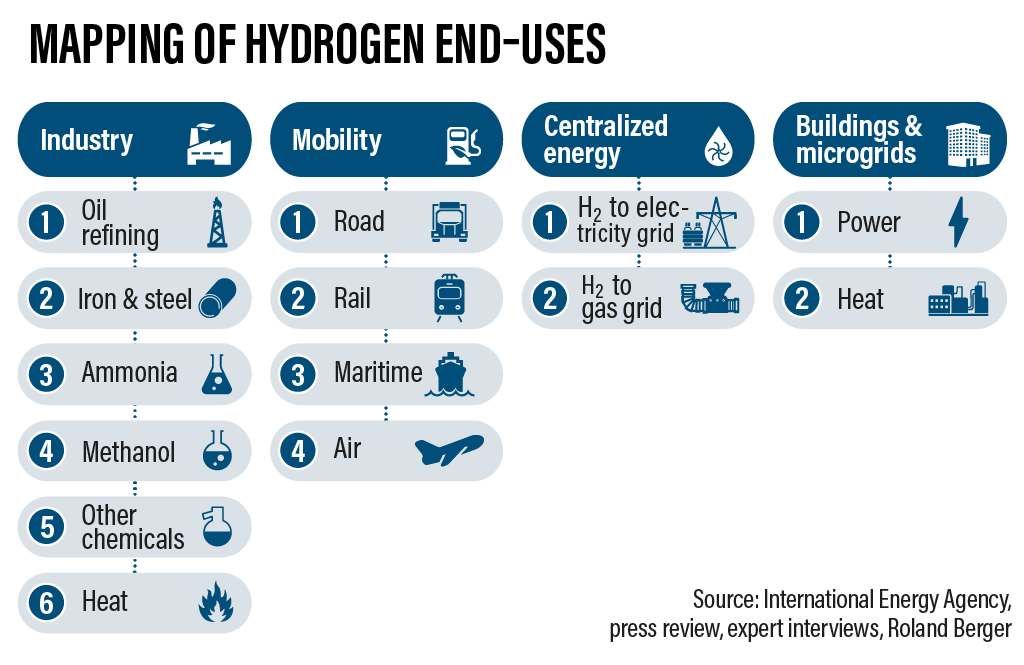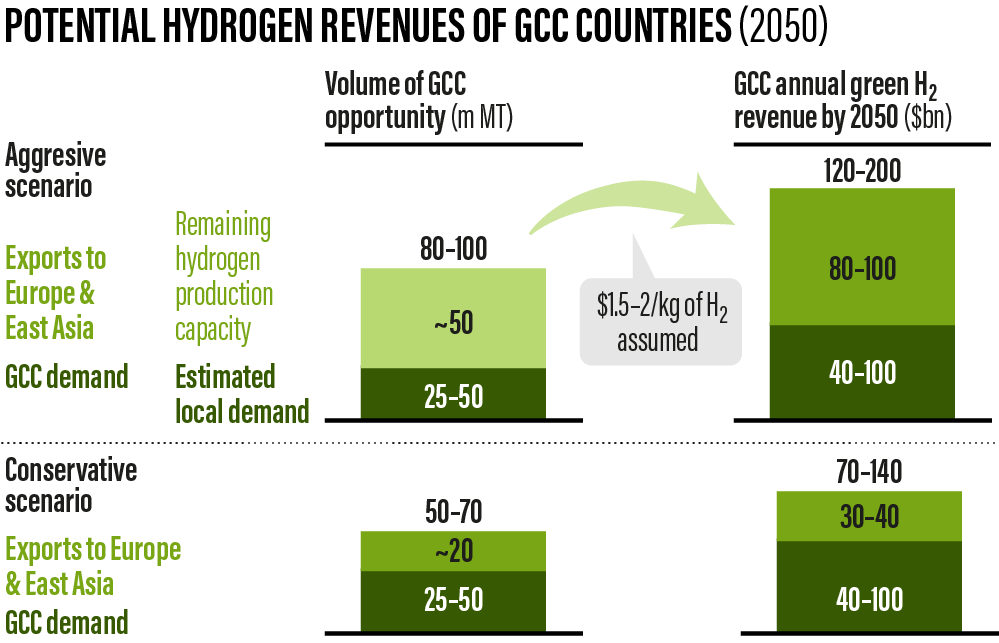Middle Eastern oil producers are making a big bet on hydrogen, the clean fuel that has been generating a lot of interest across the globe since the onset of the COVID-19 pandemic. As demand grows, the region seeks to lead the way in hydrogen production, The National News states.
Hydrogen’s rise as a favored energy source in the Middle East comes on the heels of a broader global switch to a low-carbon economy. Oil exporters are preparing for a world where crude is no longer the dominant energy source and are trying to form new economies and relationships centered around cleaner fuels.
Hydrogen, the most abundant element in the universe, has rapidly become a tool for decarburization.
Saudi Arabia, the world’s largest exporter of oil, has pledged to become the world’s top exporter of hydrogen. The UAE, OPEC’s third-largest oil producer, is drawing up a hydrogen road map and is looking to add fuel to its clean energy mix by 2050.
But can the region, with its abundant natural resources, recreate the economies of scale that helped to level the costs for solar energy projects globally and reap the industrial benefits of clean fuel?

H2. The story of Hydrogen
Hydrogen is one of the most abundant elements in the universe. It has been recognized as the “missing piece” for the energy transition. Hydrogen’s multiple positive intrinsic characteristics make it a clean and versatile energy carrier.
Extraction
Humanity can use electricity from renewable sources to electrolyze water and separate hydrogen (H2) and oxygen (O2). Hydrogen can also be extracted from natural gas using steam methane reforming.
Storage and transport
Through ammonia synthesis, hydrogen can be safely stored for transportation, long-term storage, and distribution. The ammonia can be decomposed into hydrogen again.
Power and application
In a fuel cell, hydrogen and oxygen are combined to generate electricity, heat, and water. Hydrogen atoms lose their electrons in the anode, positively charged protons pass through the membrane to the cathode, and negative electrons generate electricity.
Middle Eastern oil producers are making a big bet on hydrogen, the clean fuel that has been generating a lot of interest across the globe since the onset of the Covid-19 pandemic.
Hydrogen’s rise as a favored energy source in the Middle East comes on the heels of a wider global switch to a low-carbon economy. Oil exporters are preparing for a world where crude is no longer the dominant energy source and are trying to form new economies and relationships centered around cleaner fuels.
Hydrogen, the most abundant element in the universe, has rapidly become a tool for decarburization.

Saudi Arabia leads the way
Paddy Padmanathan, chief executive of Acwa Power, says the clean fuel can be a catalyst for a new, decarbonized industrial economy in Saudi Arabia.
“There is no particular reason why the kingdom of Saudi Arabia cannot become a steel producer – a green steel producer – on the back of very cost-competitive green hydrogen it is able to generate. So, I think the possibilities are very large,” he said.
Acwa Power and Air Products are involved in a $5 billion project – the world’s largest – to produce green hydrogen in Saudi Arabia’s futuristic city Neom.
Saudi Arabia, which accounts for 12.5% of the world’s oil production, harbors ambitions to sell hydrogen that will be transported by pipeline to Europe. Energy Minister Prince Abdulaziz believes the kingdom is the “next Germany” when it comes to renewables.
Hydrogen also has a variety of industrial uses. Gulf oil producers, who prioritize the gas for export, are looking at possible domestic uses such as in steelmaking, which currently uses coking coal to “reduce” the carbon content in the ore.
With Saudi Arabia looking to lower its emissions, hydrogen could play a broader role in its efforts to diversify and reduce its reliance on oil, its primary revenue source.
The 4-gigawatt Acwa Power Air Products project will use renewable sources to produce green hydrogen. The clean gas will then be converted to liquid ammonia, one of the most efficient ways of transporting hydrogen. The gas will be sold to buyers in the Far East who will then “recrack” to generate electricity or use it in hydrogen fuel cells in the transport sector.
Mr. Padmanathan says a significant portion would be used in refining operations and in chemical production while a smaller amount will be used to make fertilizers “and the balancing percent to a whole range of manufacturing processes. What is surprising is that hydrogen [even] ends up in lipstick”.
Types of hydrogen
· Green hydrogen
Electricity from renewable sources is used to electrolyze water and separate the hydrogen and oxygen.
· Blue hydrogen
Produced using natural gas via steam reformation. Most of the greenhouse gases are captured and stored.
· Grey hydrogen
Produced using natural gas via steam reformation but with no carbon capture and storage.
· Brown hydrogen
Produced using coal instead of natural gas, but with no carbon capture and storage.
The hydrogen economy
The hydrogen economy is expansive. The global market for green hydrogen is expected to grow to 500 million tonnes by 2050, with annual revenue set to hit $200bn in the same period, according to Dubai-based consultancy Dii and Roland Berger.
The region is likely to be positioning itself to be a $11 trillion market for hydrogen by 2050, according to Bader Chaudhry, energy sector chief at Mashreq Bank in Dubai.
“This will not be entirely internal consumption. There will be a significant consideration around exporting this energy source,” he says.
With the hydrogen economy ballooning, the bank expects financing for the sector to be largely state-led with the government seeking out technology partners.
Diversifying energy production
In the Middle East, money is pouring into both green and blue hydrogen as big oil companies such as Adnoc move to harness the potential of decarbonising their businesses by playing to their conventional strengths.
The company is pushing for large-scale production of blue hydrogen through steam methane reformation, which splits natural gas into hydrogen and carbon dioxide.
The carbon dioxide released during the process is captured and stored and is used in other industrial processes, including in the oil and gas sector, where it is pumped into mature oil wells to boost crude output.
Adnoc intends to significantly increase its hydrogen output to about 500,000 tonnes, from the 300,000 tonnes currently produced in its downstream activities.
It has also attracted partners such Fertiglobe, its joint venture with Amsterdam-listed OCI to produce a large-scale blue ammonia plant.
The state oil company plans to develop a plant with a production capacity of 1,000 tonnes and capitalise on its oil trading relationships in Asia to sell the clean form of energy.
It sold its first batch of blue ammonia to Japan’s Itochu on Monday and is also exploring options to produce the fuel with other entities.
Adnoc is part of a hydrogen alliance, formed with other state entities such as Mubadala and holding company ADQ, to develop significant production capabilities for blue and green hydrogen in the UAE.
Abu Dhabi renewable energy company Masdar, which is part of Mubadala’s portfolio, is already advancing plans for the development of a hydrogen demonstrator project as part of the alliance.
The green hydrogen manufactured will be used to power fuel cells in buses in carbon-neutral Masdar City.
The company is also running trials on sustainable hydrogen and aviation fuel blend to be used by state airline Etihad and German operator Lufthansa.
Hydrogen is 14 times lighter than air and this is inspiring structural changes within the global aviation industry, which is looking to decarbonise.
The UAE is also considering developing pink hydrogen, a product of electrolysis powered by nuclear energy. Abu Dhabi is home to the Barakah Nuclear Power Plant, which was added to the grid in 2020.
In Sharjah, Bee’ah is evaluating plans for a waste-to-hydrogen project. The UAE is also in the process of producing green steel using hydrogen from Abu Dhabi National Energy Company, better known as Taqa. Several entities such as Abu Dhabi Ports and the Khalifa Industrial Zone Abu Dhabi, or Kizad, are also developing billions of dollars worth of green ammonia projects.
Oman, a non-OPEC producer in the Gulf, has also joined the bandwagon and is developing a green hydrogen project that will have a capacity of up to 1.3 gigawatts.

The future of fuel
With so much under way in the Middle East to become a powerhouse for alternative energy, can the region help lower costs for the fuel?
With the region pouring billions of dollars into hydrogen projects, the costs of the clean fuel could fall by 30 per cent to 50 per cent by 2030 in the GCC, says Dii and Roland Berger.
The International Renewable Energy Agency, which is based in Abu Dhabi’s Masdar City, believes that record low tariffs for solar power projects among oil-exporting countries could help foster the development of cheap green hydrogen.
“The potential levelised cost of hydrogen, assuming the low solar photovoltaic and onshore wind prices from the recent auctions in Saudi Arabia, could be as little as $1.62 per kilogram of hydrogen,” the agency said in a report in June.
“This compares favorably with the hypothetical cost of natural gas steam methane reforming, with today’s carbon capture, utilization and storage costs between $1.45 and $2.40 per kg of hydrogen,” the report said.
Others such as Dii and Roland Berger, which are part of the Mena Hydrogen Alliance, expect the cost of green hydrogen to reach parity with the natural gas-powered blue hydrogen by 2025 and with the fossil fuel-based grey hydrogen by 2030.
Hydrogen can be a “commercially independent energy source” between 2040-2050, Mashreq Bank’s Mr Chaudhry says. However, the Mena region is well-placed to tap into this boom.
“MENA exporters have a competitive advantage due to potential existing markets and opportunity for capturing lost oil export demand,” says the strategy, energy economics and sustainability research team of the Arab Petroleum Investments Corporation, or Apicorp.
“With a well-established export trade in energy, synergies and cost savings via retention of oil and gas skills, infrastructure and assets, proximity to hydrogen markets, access to low-cost natural gas and access to depleted oil wells for CCUS [carbon capture, utilisation and storage], the region has a competitive advantage to emerge as a major export hub compared to other parts of the world.”
However, Apicorp expects natural gas-powered blue hydrogen to gain ground in the region before ceding market share to the green version in the future.
You may also read about renewable energy in Arabia, “the molecule of the future,” here.



